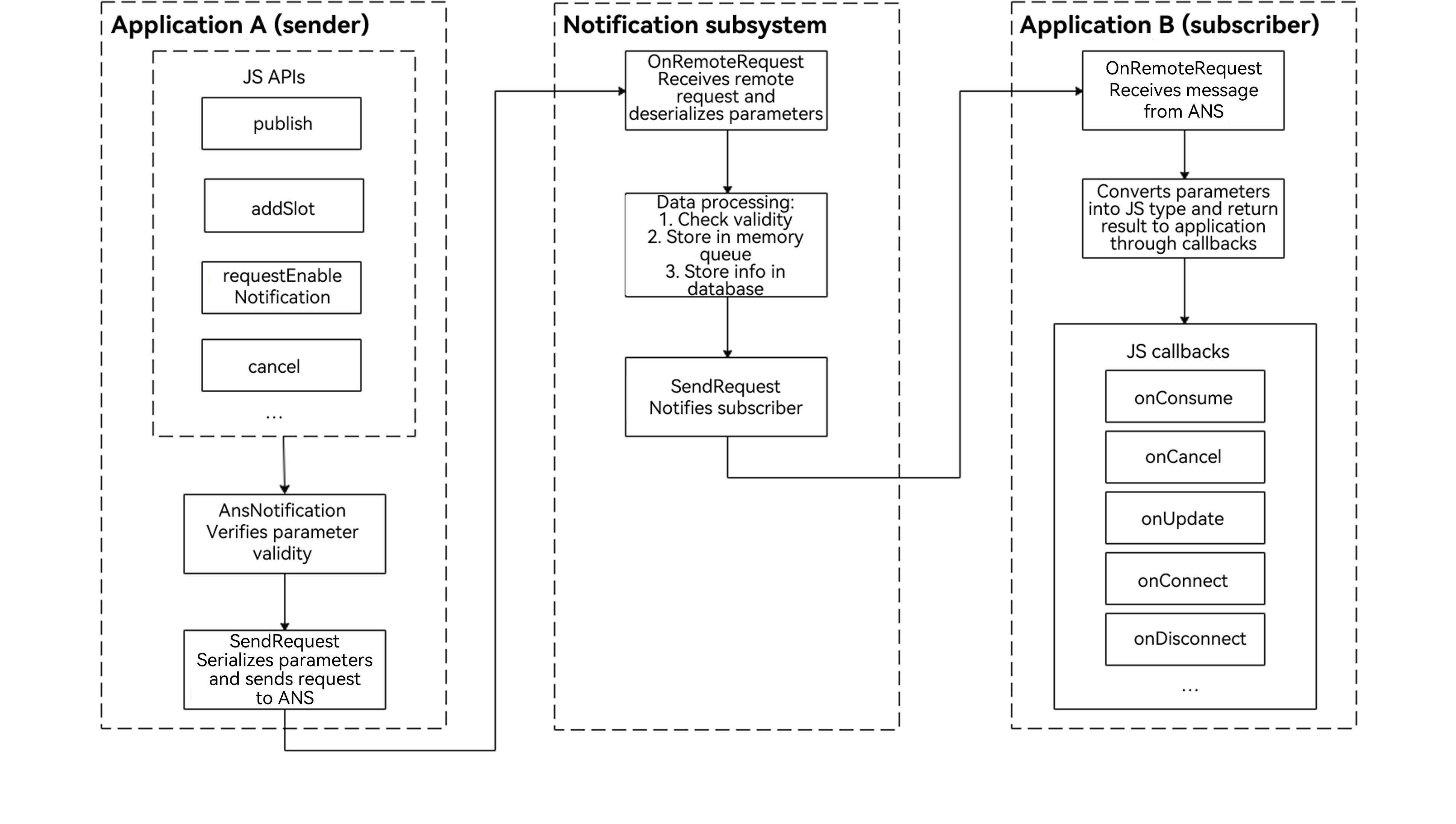harmony 鸿蒙Subscribing to Notifications (for System Applications Only)
Subscribing to Notifications (for System Applications Only)
To receive notifications, an application must subscribe to notifications first. The notification subsystem provides two types of subscription APIs, allowing applications to subscribe to notifications from all applications or notifications from a specific application.
You can use the NotificationSubscriber object to provide callbacks for subscription events, such as subscription success, notification reception, notification cancellation, and subscription cancellation.
Principle of Notification Subscription
The notification service process involves the notification subsystem, notification sender, and notification subscriber. A notification is generated by the notification sender and sent to the notification subsystem through inter-process communication (IPC). The notification subsystem then distributes the notification to the notification subscriber.
Notification sender: It can be a third-party application or a system application. Pay special attention to this role.
Notification subscriber: It can only be a system application, for example, the notification center. By default, the notification center subscribes to notifications sent by all applications on the current device to the current user. You do not need to pay attention to this role.
Figure 1 Notification service process

Available APIs
The major APIs for notification subscription are described as follows. For details about the APIs, see @ohos.notificationSubscribe (NotificationSubscribe).
Table 1 Major APIs for notification subscription
| API | Description |
|---|---|
| subscribe(subscriber: NotificationSubscriber, info: NotificationSubscribeInfo, callback: AsyncCallback<void>): void | Subscribes to notifications from a specific application. |
| subscribe(subscriber: NotificationSubscriber, callback: AsyncCallback<void>): void | Subscribes to notifications from all applications. |
Table 2 Callbacks for notification subscription
For details about the API, see NotificationSubscriber.
| API | Description |
|---|---|
| onConsume?: (data: SubscribeCallbackData) => void | Callback for receiving notifications. |
| onCancel?: (data: SubscribeCallbackData) => void | Callback for canceling notifications. |
| onUpdate?: (data: NotificationSortingMap) => void | Callback for notification sorting updates. |
| onConnect?: () => void; | Callback for subscription. |
| onDisconnect?: () => void; | Callback for unsubscription. |
| onDestroy?: () => void | Callback for disconnecting from the notification subsystem. |
| onDoNotDisturbDateChangedeprecated?: (mode: notification.DoNotDisturbDatedeprecated) => void | Callback for the Do Not Disturb (DNT) time changes. This API is deprecated since API version 11. |
| onDoNotDisturbChanged?: (mode: notificationManager.DoNotDisturbDate) => void | Callback for the Do Not Disturb (DNT) time changes. |
| onEnabledNotificationChanged?: (callbackData: EnabledNotificationCallbackData) => void | Callback for notification switch changes. |
| onBadgeChanged?: (data: BadgeNumberCallbackData) => void | Callback for notification badge number changes. |
How to Develop
Request the ohos.permission.NOTIFICATION_CONTROLLER permission. For details, see Requesting Application Permissions.
Import the notificationSubscribe module.
import { notificationSubscribe, notificationManager } from '@kit.NotificationKit';
import { BusinessError } from '@kit.BasicServicesKit';
import { hilog } from '@kit.PerformanceAnalysisKit';
const TAG: string = '[SubscribeOperations]';
const DOMAIN_NUMBER: number = 0xFF00;
- Create a subscriber object.
let subscriber:notificationSubscribe.NotificationSubscriber = {
onConsume: (data:notificationSubscribe.SubscribeCallbackData) => {
let req: notificationManager.NotificationRequest = data.request;
hilog.info(DOMAIN_NUMBER, TAG, `onConsume callback. req.id: ${req.id}`);
},
onCancel: (data:notificationSubscribe.SubscribeCallbackData) => {
let req: notificationManager.NotificationRequest = data.request;
hilog.info(DOMAIN_NUMBER, TAG, `onCancel callback. req.id: ${req.id}`);
},
onUpdate: (data) => {
hilog.info(DOMAIN_NUMBER, TAG, `onUpdate callback. req.id: ${data.sortedHashCode}`);
},
onConnect: () => {
hilog.info(DOMAIN_NUMBER, TAG, `onConnect callback.`);
},
onDisconnect: () => {
hilog.info(DOMAIN_NUMBER, TAG, `onDisconnect callback.`);
},
onDestroy: () => {
hilog.info(DOMAIN_NUMBER, TAG, `onDestroy callback.`);
},
};
- Initiate notification subscription.
notificationSubscribe.subscribe(subscriber, (err: BusinessError) => { // This API uses an asynchronous callback to return the result.
if (err) {
hilog.error(DOMAIN_NUMBER, TAG, `Failed to subscribe notification. Code is ${err.code}, message is ${err.message}`);
return;
}
});
你可能感兴趣的鸿蒙文章
harmony 鸿蒙Notification Kit (User Notification Service)
harmony 鸿蒙Publishing a Live View Notification (for System Applications Only)
harmony 鸿蒙Managing the Notification Badge
harmony 鸿蒙Canceling a Notification
harmony 鸿蒙Clearing Repeated Notifications Across Devices
harmony 鸿蒙Cross-Device Notification Management (for System Applications Only)
harmony 鸿蒙Cross-Device Notification Overview
harmony 鸿蒙Requesting Notification Authorization
harmony 鸿蒙Introduction to Notification Kit
harmony 鸿蒙Enabling Quick Reply for Cross-device Notifications
- 所属分类: 后端技术
- 本文标签:
热门推荐
-
2、 - 优质文章
-
3、 gate.io
-
7、 openharmony
-
9、 golang